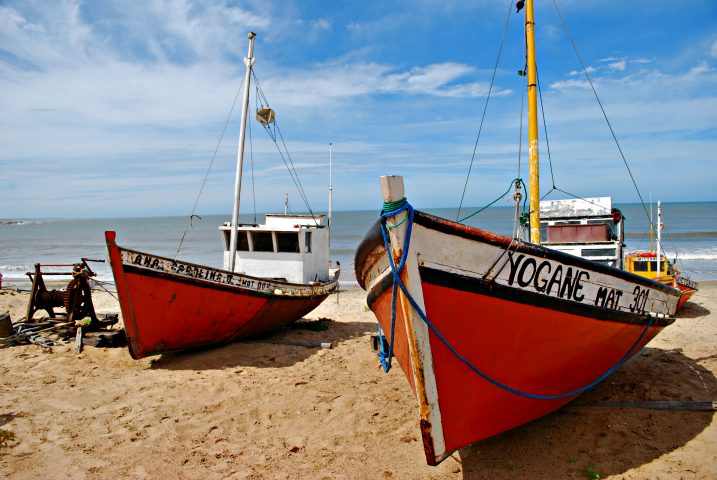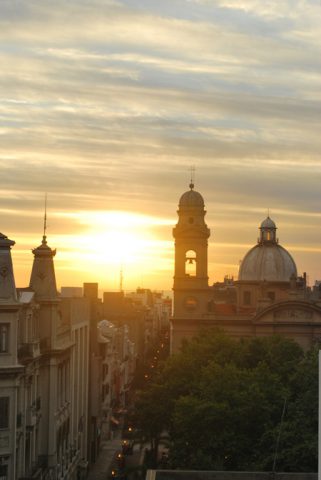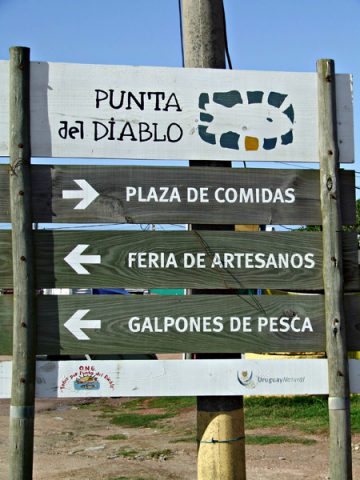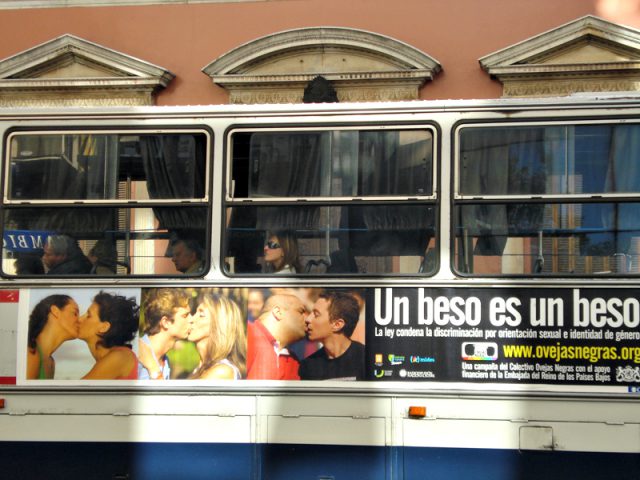“Don’t cry for me, Argenti-“ Nah! Let’s take the needle off that record. How about playing a different song? Uruguay, a little country nestled between Argentina and Brazil, offers just about anything you’d want in a South American sojourn. You’ll find pristine beaches, historic architecture, loads of local color, vineyards, gourmet food, festivals, celebrations and so much more. Best of all, last August, same-sex marriage became legal in Uruguay. So if you’re envisioning a sexy stopover with your significant other, don’t hesitate. It’s a welcoming, gay-friendly destination.
The second smallest country in South America, Uruguay is situated on the continent’s southeastern coast. With Brazil to the north and Argentina to the west and south, Uruguay shares many of those countries’ historical and cultural characteristics. If you like fruity Brazilian cocktails and thick Argentine steaks, for example, you’ll find abundant fare that’s comparable here. That being said, there’s no need to gloss over the fact that some things are uniquely Uruguayan.
As previously mentioned, Uruguay is a small country, so this mini travel guide presumes that you’ll have a base camp in Montevideo, its capital, with potential day trips or overnight excursions to other points of interest.
Most international flights arrive in Montevideo’s Aeropuerto Carrasco through Buenos Aires, Rio de Janeiro or São Paulo. If you’re coming from Argentina, you can cross over to Montevideo by ferry or bus, or a combination of both. Uruguayan buses and roads are well-maintained, so there’s no need to worry that you’ll be stuck on some rattling people-crate, shuttling along an unpaved road. (Put that dreadful image out of your mind!) Buses are actually an ideal mode of transport in Uruguay, because of its small size. Everyone uses them, and they’re safe and efficient. You could traverse the whole country by bus in just a few hours.
 Within Montevideo, you can get around by bus, tram, taxi, rented car or motorcycle. Local buses are cheap, if a little slow and crowded. Montevideo and most other Uruguayan cities have a central terminal for long-distance buses. The exceptional bus network ensures that not many people use other methods of getting around. But if you prefer a car or motorcycle, these can be rented in Montevideo and in tourist hubs, such as Punta del Este and Punta del Diablo. Taxis are plentiful and cheap. A lengthy ride in Montevideo will cost you about 115 pesos, or the equivalent of $5; short trips may only set you back a buck or two. Night and weekend fares run considerably higher, though.
Within Montevideo, you can get around by bus, tram, taxi, rented car or motorcycle. Local buses are cheap, if a little slow and crowded. Montevideo and most other Uruguayan cities have a central terminal for long-distance buses. The exceptional bus network ensures that not many people use other methods of getting around. But if you prefer a car or motorcycle, these can be rented in Montevideo and in tourist hubs, such as Punta del Este and Punta del Diablo. Taxis are plentiful and cheap. A lengthy ride in Montevideo will cost you about 115 pesos, or the equivalent of $5; short trips may only set you back a buck or two. Night and weekend fares run considerably higher, though.
Montevideo offers a profusion of options for lodging—from world-class luxury hotels to quaint guesthouses to budget hostels for students and skinflints. If you’re setting up your travel HQ in Uruguay’s capital city, don’t worry; you’ll have plenty of comfortable places to hang your gaucho hat.
At the ritzy end of the spectrum, I recommend Montevideo’s most luxurious hotel, Sofitel Montevideo Casino Carrasco and Spa (Rambla República de México 6451, +598 2604 6060, sofitel.com/gb/hotel-7969-sofitel-montevideo–carrasco-and-spa.) With its 93 well-appointed rooms and 23 suites, it’s also home to a sophisticated spa, , restaurant, bar, library and café. The building’s early 20th century, French-inspired elegance adds much to its ambience. In the mid-range, InterCity Premium (Esq. Echeverria, Ibiray 2398, +598 2711 6500, intercityhoteis.com.br/en/hoteis/hotel-intercity-premium-montevideo) is a modern, well-equipped hotel conveniently located just 100 yards from General Artigas Boulevard, the city’s main drag, with easy access to shops and restaurants. Not surprisingly, My Suites Boutique Hotel & Wine Bar (Juan Benito Blanco 674, +598 2712 3434, mysuites.com.uy/en) is an ideal choice if you’ve come to Uruguay to sample the vino. The only wine boutique hotel in Montevideo, all guests enjoy a free wine-tasting and all the rooms are suites. If you’re on a budget, and who isn’t these days, the gay-friendly Montevideo Chic Hostel (Piedras 597, +598 2915 0678, montevideohostel.com/en) is secure, clean and provides rooms as cheap as $35-$75 per night, some with private bathrooms and kitchens. The building is only three blocks from Plaza Matriz, the heart of Montevideo. Most of the city’s sights are virtually at your doorstep.
 Montevideo’s Plaza Matriz is an attractive square surrounded by colonial buildings. On weekends, it’s the site of a popular antique and flea market. There are also several restaurants in the area. When you’re done there, make your way to Sarandi, a pedestrianized street lined with bookshops, cafes, bars and the Torres Garcia Museum (Peatonal Sarandí 683, +598 2916 2663, torresgarcia.org.uy), a gallery devoted to Uruguay’s most celebrated artist.
Montevideo’s Plaza Matriz is an attractive square surrounded by colonial buildings. On weekends, it’s the site of a popular antique and flea market. There are also several restaurants in the area. When you’re done there, make your way to Sarandi, a pedestrianized street lined with bookshops, cafes, bars and the Torres Garcia Museum (Peatonal Sarandí 683, +598 2916 2663, torresgarcia.org.uy), a gallery devoted to Uruguay’s most celebrated artist.
For nightlife, head to Bartolome Mitre, between Sarandi and Buenos Aires streets, in the old part of the city called Ciudad Vieja. It’s a street full of restaurants, a mix of gay and straight bars and a plethora of live music venues. Just a caveat: nightlife in Montevideo starts late (around 10pm) and on the weekends can go on until sunrise. Uruguayans like to party hard! Head to Chueca (Brandzen 2172 bis, pubs.com.uy/discotecas-pubs-boliches/chueca-montevideo) a chillaxin’ dance club/lounge, for some cocktails and conversation before heading over to Il Tempo (Gonzalo Ramirez 2121, +598 98 679 533, iltempoclub.com), a diverse dance club where the hot girls are likely to be, especially on Saturday nights. For a more traditional vibe, check out Baar Fun Fun (1229 Mercado Central, +598 2915 8005, barfunfun.com) Montevideo’s oldest tango bar.
Uruguayan cuisine is quite similar to that of Argentina, so vegans, take heed. For steaks, seafood, chivitos (Uruguayan steak sandwiches—slurp!) and other carnivorous delights, walk or take a cab to Mercado del Puerto. Once a train station, it’s now a market with a collection of restaurants specializing in meat-based dishes and fresh-caught fish. For delectable fusion cuisine, you can’t go wrong with Tandory (Ramon Masini esq. Libertad, +598 2709 6616, tandory.com.uy.), featuring more options for vegetarians/vegans, including gourmet pasta dishes. Another good choice for those on plant-based diets is WASA Ethnik Food (Calle Zabala 1341, no website) for lunch offerings, including smoothies and green salady things.
Colonia del Sacramento, a town located about 100 miles northwest of Montevideo, boasts an enchanting historic quarter that is now a UNESCO World Heritage Site. It was founded by the Portuguese in 1680, and its well-preserved buildings exemplify the fusion of Portuguese, Spanish and post-colonial architectural styles.
About 70 miles southeast of Montevideo is Punta del Este, a spectacular year-round resort town with a pleasant, oceanic climate, beaches, an iconic lighthouse and all manner of things nautical. You’ll also find shops, restaurants, bars, galleries, theaters and s. If you’re a Coastal Living kind of tourist, it’s well worth spending a couple of days here—or even a week or more.
A bit further, 185 miles east of Montevideo, is Punta del Diablo, a seaside fishing village and artists’ community that’s a wildly popular target for Argentinian, Brazilian and European vacationers. But don’t let that scare you off. It’s a must-see Uruguayan destination. With its sparkling ocean, white sand beaches and picturesque fishing boats, it’s not hard to see why people of all stripes flock here. The scene is pleasant and gay-friendly, with casual open bars that are popular with surfers. While you’re here, trek over to Parque Nacional Santa Teresa, a coastal national park with dunes, hiking trails, birding, whale watching and breathtaking ocean views.
 Situated due east about 70 miles is Maldonado, a Uruguayan coastal department that offers wonderful sightseeing, historic architecture and jaw-dropping photo ops. See the San Fernando de Maldonado Cathedral, a 19th century neoclassical church; Torre del Vigia, an 1800 watchtower; and Cuartel de Dragones, an 18th century Spanish garrison. Like Punta del Este and Punta del Diablo, Maldonado is home to windswept beaches and a profusion of little seaside villages and colorful fishing boats.
Situated due east about 70 miles is Maldonado, a Uruguayan coastal department that offers wonderful sightseeing, historic architecture and jaw-dropping photo ops. See the San Fernando de Maldonado Cathedral, a 19th century neoclassical church; Torre del Vigia, an 1800 watchtower; and Cuartel de Dragones, an 18th century Spanish garrison. Like Punta del Este and Punta del Diablo, Maldonado is home to windswept beaches and a profusion of little seaside villages and colorful fishing boats.
To sum up, fellow travelers, Uruguay is an LGBT-friendly destination with so much to offer—great people, a fascinating history, diverse culture, sightseeing and more than 400 miles of exquisite coastline. Bring a real camera with you, because your iPhone may not be up to the task of capturing the picture-postcard beauty of this South American jewel.














What Do You Think?